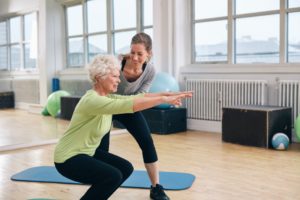Our month of education continues: So many clients, older adults and people in general have asked this question, What is Osteoarthritis? Here are your answers:
Sometimes called degenerative joint disease or degenerative arthritis, osteoarthritis (OA) is the most common chronic condition of the joints, affecting approximately 27 million Americans. OA can affect any joint, but it occurs most often in knees, hips, lower back and neck, small joints of the fingers and the bases of the thumb and big toe.
In normal joints, a firm, rubbery material called cartilage covers the end of each bone. Cartilage provides a smooth, gliding surface for joint motion and acts as a cushion between the bones. In OA, the cartilage breaks down, causing pain, swelling and problems moving the joint. As OA worsens over time, bones may break down and develop growths called spurs. Bits of bone or cartilage may chip off and float around in the joint. In the body, an inflammatory process occurs and cytokines (proteins) and enzymes develop that further damage the cartilage. In the final stages of OA, the cartilage wears away and bone rubs against bone leading to joint damage and more pain.
Who’s Affected?
Although OA occurs in people of all ages, osteoarthritis is most common in people older than 65. Common risk factors include increasing age, obesity, previous joint injury, overuse of the joint, weak thigh muscles, and genes.
- One in two adults will develop symptoms of knee OA during their lives.
- One in four adults will development symptoms of hip OA by age 85.
- One in 12 people 60 years or older have hand OA.
Treatments:
Osteoarthritis is a chronic (long-term) disease. There is no cure, but treatments are available to manage symptoms. Long-term management of the disease will include several factors:
- Managing symptoms, such as pain, stiffness and swelling
- Improving joint mobility and flexibility
- Maintaining a healthy weight
- Getting enough of exercise
Physical Activity
One of the most beneficial ways to manage OA is to get moving. While it may be hard to think of exercise when the joints hurt, moving is considered an important part of the treatment plan. Studies show that simple activities like walking around the neighborhood or taking a fun, easy exercise class can reduce pain and help maintain (or attain) a healthy weight.
Strengthening exercises build muscles around OA-affected joints, easing the burden on those joints and reducing pain. Range-of-motion exercise helps maintain and improve joint flexibility and reduce stiffness. Aerobic exercise helps to improve stamina and energy levels and also help to reduce excess weight. Talk to a doctor before starting an exercise program.
The U.S. Department of Health and Human Services recommends that everyone, including those with arthritis, get 150 minutes of moderate exercise per week.
Weight Management
Excess weight adds additional stress to weight-bearing joints, such as the hips, knees, feet and back. Losing weight can help people with OA reduce pain and limit further joint damage. The basic rule for losing weight is to eat fewer calories and increase physical activity.
Stretching
Slow, gentle stretching of joints may improve flexibility, lessen stiffness and reduce pain. Exercises such as yoga and tai chi are great ways to manage  stiffness.
stiffness.
Pain and Anti-inflammatory Medications
Medicines for osteoarthritis are available as pills, syrups, creams or lotions, or they are injected into a joint. They include:
- Analgesics. These are pain relievers and include acetaminophen, opioids (narcotics) and an atypical opioid called tramadol. They are available over-the-counter or by prescription.
- Nonsteroidal anti-inflammatory drugs (NSAIDs). These are the most commonly used drugs to ease inflammation and related pain. NSAIDs include aspirin, ibuprofen, naproxen and celecoxib. They are available over-the-counter or by prescription.
- Corticosteroids. Corticosteroids are powerful anti-inflammatory medicines. They are taken by mouth or injected directly into a joint at a doctor’s office.
- Hyaluronic acid. Hyaluronic acid occurs naturally in joint fluid, acting as a shock absorber and lubricant. However, the acid appears to break down in people with osteoarthritis. The injections are done in a doctor’s office.
Physical and Occupational Therapy
Physical and occupational therapists can provide a range of treatment options for pain management including:
- Ways to properly use joints
- Heat and cold therapies
- Range of motion and flexibility exercises
- Assistive devices
Assistive Devices
Assistive devices can help with function and mobility. These include items, such as like scooters, canes, walkers, splints, shoe orthotics or helpful tools, such as jar openers, long-handled shoe horns or steering wheel grips. Many devices can be found at pharmacies and medical supply stores. But some items, such as custom knee braces and shoe wedges are prescribed by a doctor and are typically fitted by a physical or occupational therapist.
Natural and Alternative Therapies
Many people with OA use natural or alternative therapies to address symptoms and improve their overall well-being. These include nutritional supplements, acupuncture or acupressure, massage, relaxation techniques and hydrotherapy, among others.
Surgery
Joint surgery can repair or replace severely damaged joints, especially hips or knees. A doctor will refer an eligible patient to an orthopaedic surgeon to perform the procedure.
Positive Attitude
Many studies have demonstrated that a positive outlook can boost the immune system and increase a person’s ability to handle pain.
So, keep a positive attitude, do your stretching and Engage In Life, Engage In Wellness!!!!!!!!
My next article will talk about how Physical Therapy can help Osteoarthritis.
Regards,
Kimberly Jacob, PT, CNDT, BCST
Remember: Integrative Therapy and Wellness comes to you!!!! Contact me at kim@integrativetherapywellness.com


